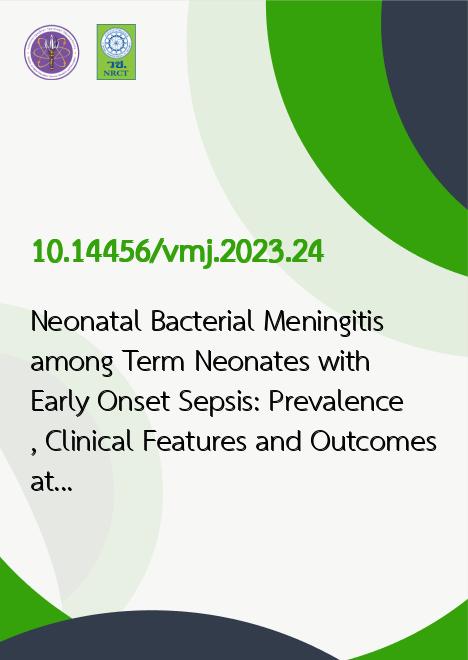
|
Neonatal Bacterial Meningitis among Term Neonates with Early Onset Sepsis: Prevalence, Clinical Features and Outcomes at a Tertiary Care Center in Thailand: a Retrospective Study over a 7-Year Period (2013-2019) |
|---|---|
| รหัสดีโอไอ | |
| Creator | 1. Preawkalaya Suksai 2. Pathaporn Prempraphana |
| Title | Neonatal Bacterial Meningitis among Term Neonates with Early Onset Sepsis: Prevalence, Clinical Features and Outcomes at a Tertiary Care Center in Thailand: a Retrospective Study over a 7-Year Period (2013-2019) |
| Publisher | Text and Journal Publication |
| Publication Year | 2566 |
| Journal Title | Vajira Medical Journal: Journal of Urban Medicine |
| Journal Vol. | 67 |
| Journal No. | 4 |
| Page no. | none |
| Keyword | bacterial meningitis, early onset neonatal sepsis, lumbar puncture, term neonates |
| URL Website | https://tci-thaijo.org/index.php/VMED |
| Website title | Vajira Medical Journal: Journal of Urban Medicine |
| ISSN | 2822-1192 |
| Abstract | OBJECTIVE: To determine the prevalence and clinical features associated with early onset neonatal bacterial meningitis (EONBM) in term infants with early onset neonatal sepsis (EOS). METHODS: This was a retrospective descriptive study of term neonates with EONBM (defined as diagnosis of proven meningitis within 72 hours of age) at Vajira hospital during 20132019. Data from medical records including demographic data, cerebrospinal fluid (CSF) analysis, microbiological results, and neonatal outcomes were reviewed. RESULTS: There were 1,203 term neonates with EOS. Of these, 18 neonates were diagnosed with EONBM, which corresponded to a prevalence of 15.0 cases per 1000 term neonates with EOS. A total of 409 (34.0%) neonates with EOS underwent lumbar puncture (LP) within 72 hours of age, of which 4.4% had EONBM. Of the 18 neonates with EONBM, 1 (5.6%), 2 (11.1%), and 15 (83.3%) neonates had positive CSF Gram stain, latex agglutination test, and CSF white blood cell >20 cells/millimeter3 (mm3), respectively. All neonates with EONBM had negative blood and CSF culture. Median gestational age and birthweight were 39.0 (Interquatile range [IQR] 37.039.0) weeks and 3.3 (IQR 2.93.4) kg, respectively. Apnea (adjusted odds ratio [aOR] 57.2; 95% confidence interval [CI] 7.1460.9), history of maternal chorioamnionitis (aOR 13.66; 95% CI 2.0889.59), and absolute neutrophil count ?18,000 cells/mm3 (aOR 7.05; 95% CI 2.1323.30) showed a significant association with EONBM. CONCLUSION: The prevalence of EONBM in this cohort of term neonates with EOS was relatively low. The current literature does not provide the definite elucidation of risk factors associated with EONBM. A promptly performed LP remains a challenge in neonates with clinical or laboratory indices suggestive of EOS. |
